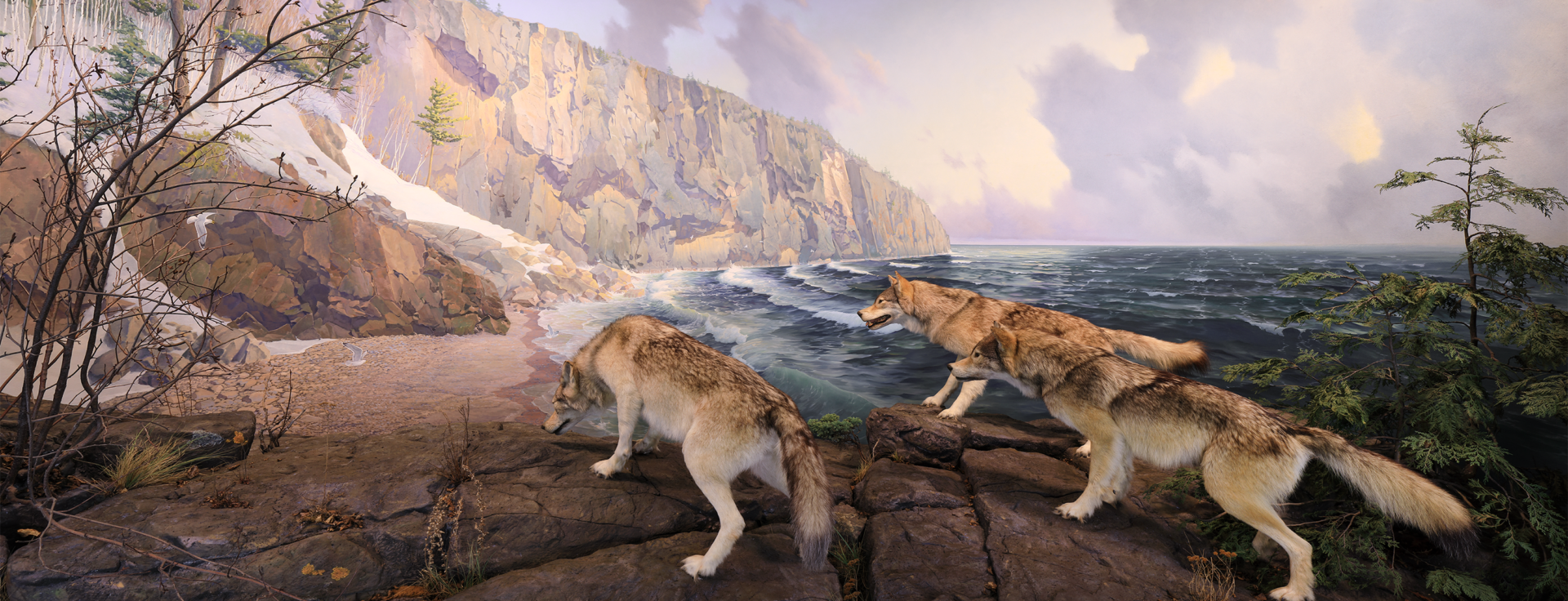
Diorama Spotlight: Wolves at Shovel Point
Published09/15/2020 , by Jennifer Menken, education collections manager
Along the North Shore, April is a time when winter and spring battle. We see this in the Wolves at Shovel Point diorama: the ice is out but late spring snow still rests under the trees. Herring gulls circle over waves of Lake Superior looking for small fish and other food to be washed ashore. The magnificent Shovel Point juts out into the icy cold waters of Lake Superior in the background. In the foreground, a small pack of gray wolves trots along the 1.1 billion year old volcanic rock, basalt, that makes up the North Shore of Lake Superior. The wolves pass straggly plants growing in the inhospitable windswept cracks of the basalt, northern red cedar and black spruce trees struggle to grow there. The wolves may be on the hunt for a white-tailed deer, such as the one watching from a distance.
The diorama depicts a point in time after lumber harvesting had removed much of the old growth red and white pine forests. What came in afterwards was a mix softwoods, such as aspen and birch. This transition changed the makeup of the animals in the forest: woodland caribou were extirpated from the state and the moose population fell. White-tailed deer moved into the new habitat, and wolves adapted to this new food source. Today, the Minnesota wolf diet consists mainly of white-tailed deer, moose, and beaver.
In the late 1930s, when this diorama was being conceived, wolves were considered vermin. An active eradication program had nearly eliminated them from the United States, but Minnesota was one of their last strongholds. A great debate was taking place about the importance of wolves to the environment. Then-director of the Bell Museum, Thomas Sadler Roberts, hired naturalist Walter Breckenridge and artist Francis Lee Jaques to create the first new diorama for the soon-to-be opened building at 10 Church Street (opened in 1939). To counter the popular view of wolves, the story for the diorama was carefully conceived to depict wolves as a family, working together to sustain the group. Up until this point wolves were usually depicted as vicious and wanton killers, but here they were shown as important parts of an ecosystem, involved in their own complex social interactions.
Their creation inspired many to reexamine their attitudes towards these extraordinary animals. Since the 1974 Endangered Species Act, Minnesota’s wolf populations have rebounded, and debate continues about how much, if any, hunting of wolves should be allowed. In making this diorama, the Bell Museum developed distinctive approaches to education, focusing on immersive learning, particular places, and storytelling that continue to engage the public today.
Location: Shovel Point on Lake Superior in what is now Tettegouche State Park. North Shore of Lake Superior, near the mouth of the Baptism River, Lake County, Minnesota
Biome: North Woods
Season: April
Date completed: 1942
Dimensions: 10’x 20’
Background Artist: Francis Lee Jaques
Foreground Artist: Walter J. Breckenridge
Restoration 2017: Midwest Art Conservation Center, Chase Studios, Museum Professionals, and Split Rock Studios
Donors: James Ford Bell – founding donor, Diorama Legacy Society – restoration donor







